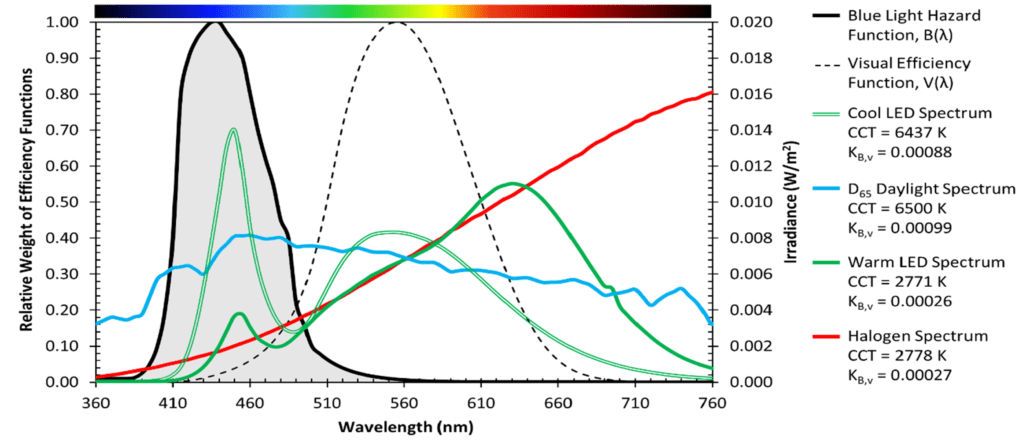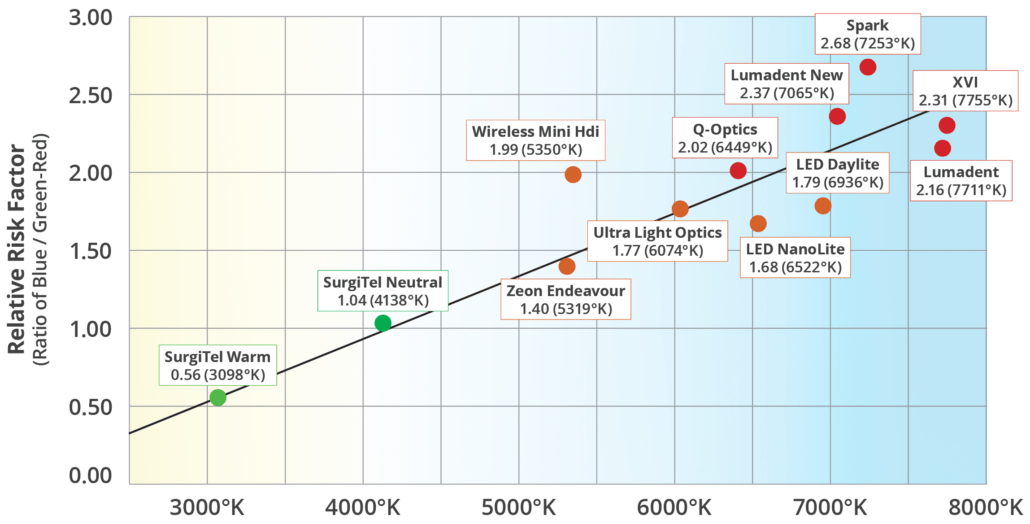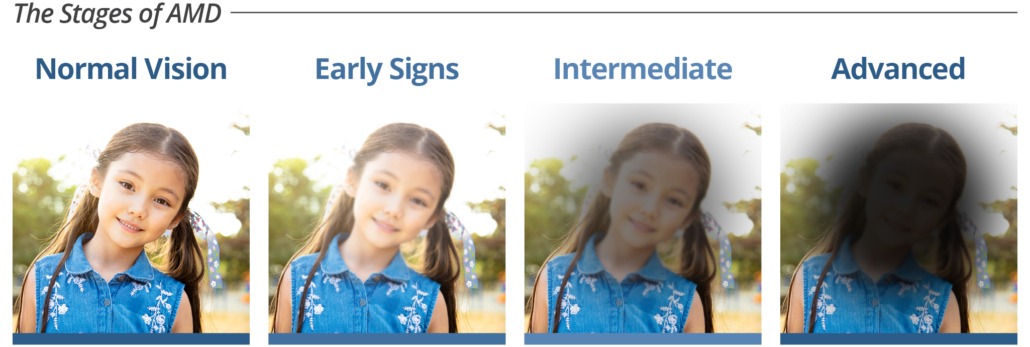What They Didn’t Teach You About Dental Lights in Dental School!

ErgoPractice News – May 2021
By Jin Chang PhD
jchang@surgitel.com
Summary
Key selection factors of dental LED headlights are “balanced spectral distribution” (i.e., the peak of the blue spectral band is similar to the peak of the green-red spectral band) and “uniform and consistent beam pattern” which should not vary as the working distance changes. The ideal beam profile may be bright at the central area and becomes dimmer at the edges of the beams. It is proven that SurgiTel neutral LED lights can offer the best color accuracy and the safest to eyes.
Requirements of LED Headlights as Dental Illumination
White LED lights consist of two spectral bands: “Blue” spectral band and “Green-Red” spectral band. Figure 1 shows spectral distributions of various brand LED headlights which are being used by dental professionals today.1 As the dental illumination, LED headlights should meet two basic requirements. The first requirement is to help show the accurate color of objects such as teeth and tissues. The second requirement is to minimize the blue light hazard.2-6 Figure 2 shows the blue light hazard function and the visual efficiency (photopic response) function of eyes with spectral distributions of four example lights.7 The blue spectral band of LED lights is just under the blue light hazard function. It is noted that eyes have a good defensive mechanism against UV and visible lights (excluding blue), but eyes are defenseless against the blue light because eyes are not sensitive to the blue light.4

Figure 1: Spectral Distributions of Various Brand LED Headlights which Are Used by Dental Professionals

Figure 2: Four Spectral Distributions and Blue Light Hazard & Visual Efficiency (Photopic Response) Functions
To meet both first and second requirements, the beam of LED headlights should have a balanced color spectrum – the blue spectral band peak is similar to the green-red peak spectral peak. Figure 3 shows the ratio (or relative risk factor by LED blue light) of blue spectral peak over green-red spectral band peak for various brand LED lights which have been used by dental professionals. SurgiTel neutral LED lights offer the most color-balanced beam which has been proven to have the best color accuracy.8,9 Figure 4 shows example images under the illumination of SurgiTel neutral LED and under the illumination of LumaDent lights. As the ratio increases, the blue light hazard increases. Figure 5 shows the relationship between CCT (corrected color temperature) and relative risk factor by the LED blue light (ratio of blue spectral band peak over green-red spectral band peak). Exposure to LED lights with strong blue spectral bands for an extended period of time can create age-related macular degeneration (AGD). Figures 6 and 7 show the physical effect of blue light on retina cells10 and the visual effect of AMD respectively.

Figure 3: Relative Risk Factor by LED Blue Light for various brands of LED light.
Ratios taken from reflected light at 35cm. Kelvin color temperature measured from direct viewing.

Figure 4: Example Images under the Illumination of SurgiTel Neutral LED Light and the Illumination of LumaDent LED light.

Figure 5: Relationship between Blue/Green-Red Ratios and Kelvin Color Temperature. Ratios taken from reflected light at 35cm. Kelvin color temperature measured from direct viewing.

Figure 6: Effect of Blue Light on Retina Cells10

Figure 7: Visual Effect of Age-related Macular Degeneration (AMD)
The next important factor to achieve the best image with good color accuracy and good contrast is that beams should be uniform and have a consistent beam pattern. To generate uniform consistent beams, SurgiTel invented the true color beam-forming optical technology which maintains the beam pattern throughout the wide range of working distance. It is noted that if beam-forming optics does not use the true color beam-form technology, the color temperature of beams may be significantly higher than LED light sources.
Lastly, we may consider the brightness of the beam. Let’s think about what good illumination is. Many people think that the brightest light is the best, but too bright illumination is bad because eyes cannot achieve an optimum brightness on the retina by adjusting the iris. Too bright illumination will wash out details of objects. Under good illumination, the pupil size of human eyes can be adjusted by the iris between 1mm and 2mm. It is noted that the pupil size is about 1mm under very bright illumination and 8mm in dark. If you compare two lights side by side, you can tell the difference in brightness, but if you see each light separately, you cannot see any difference because your eyes’ iris will control the amount of light reaching the retina to create an optimum brightness for the best image. If your eyes feel too bright, the brightness of the light is too high and thus it is a bad illumination. Considering the ability of eyes, the wide range of brightness of lights is acceptable. Since most dental LED headlights meet the brightness requirement, the brightness of a LED headlight is not the first selection factor.
How to Evaluate Your Current LED Lights?
It is very difficult to estimate the degree of coolness of the LED beam you are using. The best way is to compare the beam of current LED headlight with a true color neutral LED headlight which have a balanced color spectrum and safest to eyes. The SurgiTel true color neutral LED light can be used as the reference light. (As shown in Figure 4.)
If you contact us, we can help you evaluate your current LED headlights by comparing them with our true color neutral LED headlights.
References
- Price R, “Spectral Distributions of Various Brand LED headlights.” Private Communication, May 2021
- Stamatacos, Catherine, DDS; Janet L. Harrison, DDS. “The Possible Ocular Hazards of LED Dental Illumination Applications.” TDA Journal – Continuing Education 93-2 #51 (2013): 25-31. Web. 22 Oct. 2015.
- Price Curing Lab. “The Blue Light Hazard in Medicine and Dentistry.” YouTube. Price Curing Lab, 22 July 2012. Web. 24 Apr. 2015. (https://www.youtube.com/watch?v=VfCmL4Kz2iw)
- Chang BJ, Is your LED Headlight Types Safe for Your Eyes? ErgoPractice News Nov, 2018 (https://www.surgitel.com/is-your-led-headlight-type-safe-for-your-eyes)
- OPINION of the French Agency for Food, Environmental and Occupational Health & Safety on the “effects on human health and the environment (fauna and flora) of systems using light-emitting diodes (LEDs)”; ANSES Opinion Request No. 2014-SA-0253; Maisons-Alfort, 5 April 2019
- Fluent, Marie, DDS; Jack Ferracane, PhD; James Mace, DDS; Anjali Shah, MD; Richard Price, DBS, DDS, MS, FDS, RCS (Edin), FRCD (C), PhD. “Shedding Light on A Potential Hazard, Dental Light-Curing Units” JADA 2019: 150(12): 1051-1058
- US Department of Energy, “Solid-State Lighting Technology Fact Sheet,” June 2013
- “Clinical Guidelines for Selecting Loupes.” Gordon J. Christensen Clinicians Report 9, no. 8 (August 2016): 1–2. https://www.cliniciansreport.org/products/dental-reports/clinical-guidelines-for-selecting-loupes-is-overhead-led-lighting-ready-for-dental-operatories-are-scanning-and-milling-for-you-august-2016-volume-9-issue-8.
- “Cordless LED Headlamps: A Bright Idea?” Gordon J. Christensen Clinicians Report 10, no. 5 (May 2017): 1–2. https://www.cliniciansreport.org/products/dental-reports/cordless-led-headlamps-a-bright-idea-wipe-disinfection-killing-or-spreading-the-germs-radiation-are-you-and-your-patients-and-staff-protected-%E2%80%93-may-2017-volume-10-issue-5.
- Neelam K, Zhou S, and Eong K., “The Role of Blue Light in the Pathogenesis of Age-Related Macular Degeneration,” Points de Vue – number 71, August 2014: www.pointsdevue.net



